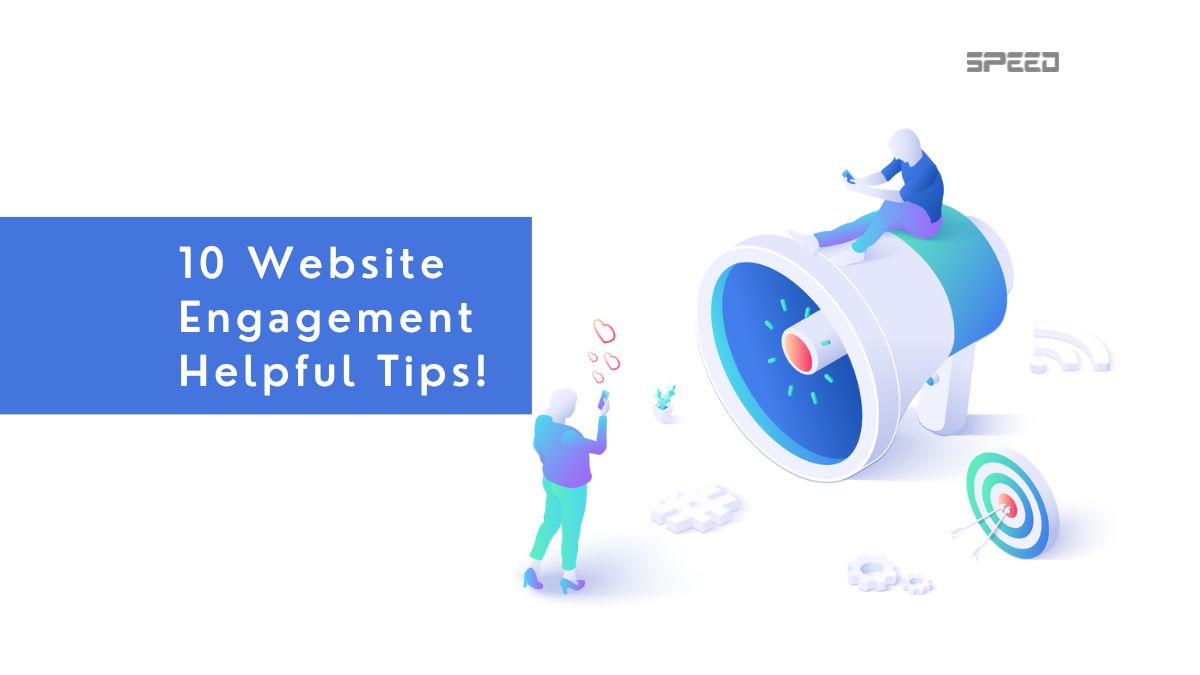Why do websites need website engagement?
Website engagement is important for any website, especially online businesses. You need to make sure that your website gets the relevance it has from the start. If it seems that no one is visiting your website because it is not engaging enough.
Then you better make an effort to increase the engagement of your website. These tips are a good starting point for that! These 10 tips will help you get better results in the long run, so do not be afraid to try them out!
Engagement is an important metric for businesses because it shows a user’s interest in what you have to say. A high level of engagement indicates that the user is spending time on your site and engaging with your content. This means they are likely considering what you have to say and might be ready to make a purchase or sign up for your mailing list.

What is user engagement, and why should you care?
Engagement is the level of interaction a user has with your content or website. It can be measured in terms of time spent on the page, number of views, shares, and likes.
The term “engagement” may seem like a vague buzzword that is difficult to understand, but it absolutely doesn’t mean just clicking on ads. Engagement can be defined as the act of actively using a website over time, which ultimately results in conversion.
Engagement can be defined in different ways, but one common definition is “the act or process of engaging with something.” This includes things like clicking through from one page of content to another, leaving a comment on an article, subscribing to a blog email list, or following you on social media.
There are several factors that can contribute to engagement levels on a website or blog. Some common drivers of engagement include providing valuable content, using interactive elements such as polls or questionnaires, and creating helpful guides or tutorials.
By understanding how users are interacting with your content and improving the quality of that interaction, you can drive more traffic back to your site and increase conversion rates.
An engaged user is a potential conversion
By now you may already know that no business can survive without an engaged user base. Engaged users are more likely to spend money, share your content, and convert into customers. It’s not enough for a website to be viewed, it must also be engaging.
An engaged user is a potential customer. When they engage with your content, they have the opportunity to view what you have to offer and, if it meets their needs, make a purchase. It’s important to have a steady stream of engaged users on your site so you can continually convert them into customers.
Why increasing website engagement is important?

Engagement is important for two reasons. First, it helps you to measure the success of your content marketing campaigns. Second, engagement helps you to target your audience more effectively by understanding their interests and motivations.
Imagine you are writing a factual, beautifully presented study on content that puts people first, but your website takes too long to load, the fonts are hard to read, and the layout is too cluttered with banners and articles. That alone has a negative impact on visitors, and they will surely leave in less than a minute. In a few words: Your website lacks engagement.
Engagement is important on websites because it helps increase the likelihood that a person will return to your website again and again.
The more engagement your website experiences, the more likely it is that more people will see your ads and landing pages, which may prompt them to buy products or sign up for services.
This engagement, the sum of all actions, sends signals to search engines, which can then easily determine that your website deserves better visibility on search results pages. In other words, engagement is important not only to attract new visitors (and thus potential customers) but also to keep them once they are there.
There are many factors that contribute to higher engagement on websites – these include creating high-quality content that people want to read and share, designing compelling layouts, using interactive features like polls and quizzes, hosting contests, and building strong relationships with other businesses in your niche.
10 helpful ways to increase engagement on websites?
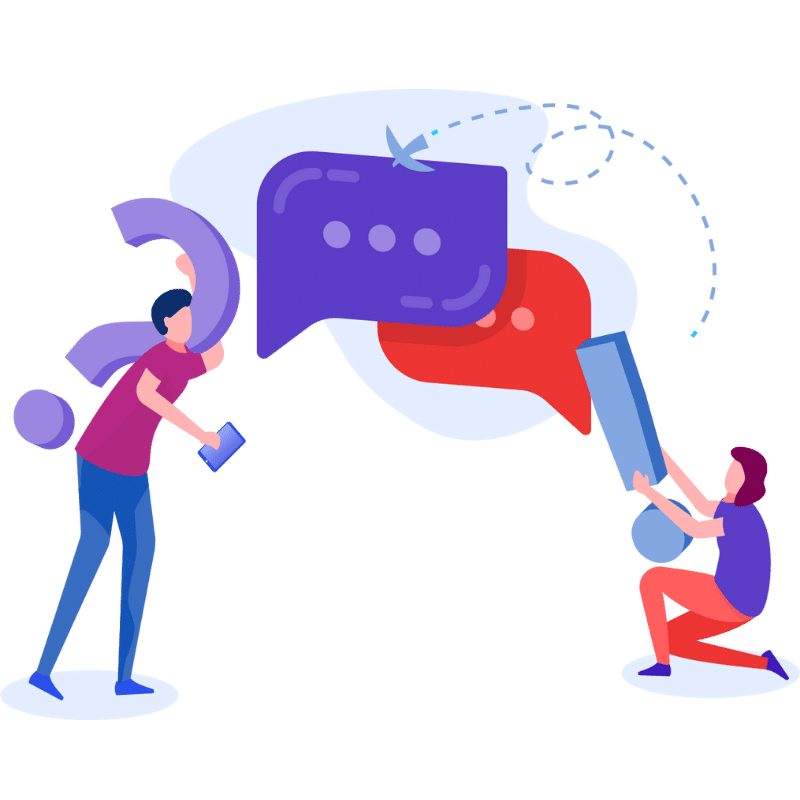
These 10 tips are the result of a study conducted by our team at Speed SEO Online Marketing.
The goal is to help our readers find ways that are proven to increase website engagement.
I will first tell you the 10 tips and then go into more detail about each one.
- Use People-first content to increase engagement
- Web design strategies to increase website engagement
- User experience strategies to increase engagement on your website
- Increasing engagement through social media strategies
- Email marketing methods to increase engagement
- Pop-ups and other forms of intrusive advertising used for a better web engagement
- The role of Calls to Action and engagement
- Mobile-friendly websites and engagement rates
- The importance of providing helpful resources
- A/B Testing to increase your website engagement
Yes, these are all ways to increase engagement on websites, but the most important thing is to figure out what works best for your website and audience. Some of the above are mandatory, others you’ll just have to try until you find strategies that work well for you and your website’s goals.
Mandatory web engagement best practices:
- People-first content
- Web design
- User experience
- Mobile-friendly
- helpful resources
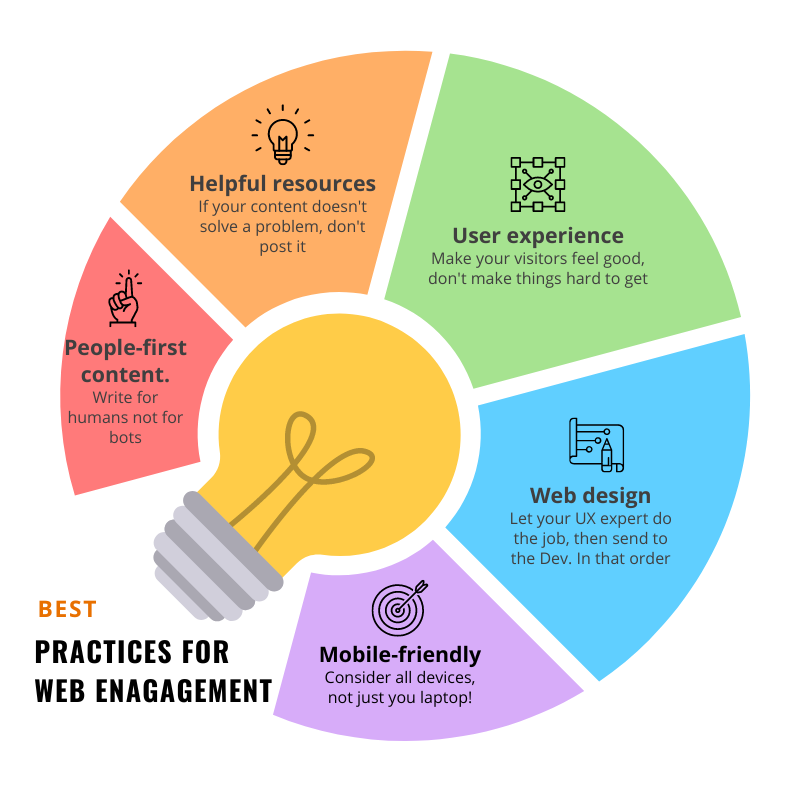
Now let’s dive deep into the main 10 ways to increase engagement on your website.
1. How can you use people-first content to increase engagement?
Ok, be careful here, you need to grab this snake by the neck and dominate it carefully. Let me ask you this, do you know what people-first content is?
What is people-first content?
People-first content is content that focuses on the needs of people facing a specific challenge and looking for a solution to it. Does your website content provide solutions for your target audience? If not, then you need to update your content ASAP.
How can you tell if your content is for people first?
First, you need to go and read Google’s upcoming core update called Google’s Helpful Content Update.
In that article, you will find this series of questions, and when you answer them, you will know if your content is considered to be people-first content.
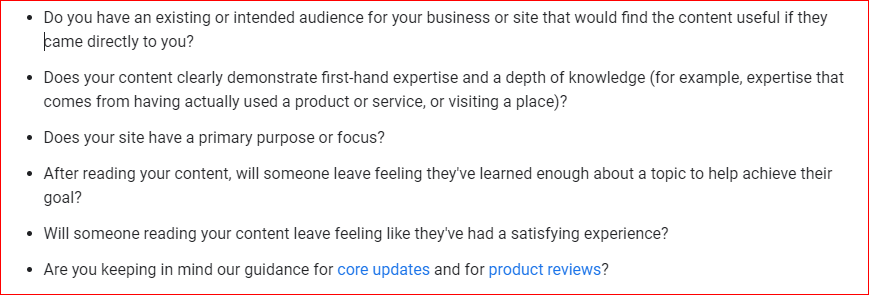
Increasing engagement on your website starts by creating content that is interesting, but more than this, useful for your target audience. This will keep them coming back, and it may also lead to conversions.
Creating engaging people-first content can be a powerful way to increase interactions on your website. It can help you attract more visitors. Content that engages visitors is something that people will want to read and share, which means that it’s likely to generate positive results for your site overall.
There are a number of ways you can create engaging people-first content, but the most important thing is to focus on what interests your target audience. Once you’ve identified your target audience’s interest, start writing about topics that matter to them in an interesting and informative way.
You’ll also need effective promotion strategies if you want people who haven’t heard of your site yet to take notice. By creating quality content and using strategic marketing tactics, you can have a significant impact on the success of your online business.”
How about pictures of people interacting with the product?
People buy more when they feel a personal connection with your brand. That is why you should use customer reviews and testimonials, videos of people talking about the product, before-and-after pictures, and pictures of people interacting with the product to help increase website engagement.
2. Web design strategies to increase website engagement?
Web design plays a big role when it comes to engagement. Basically, your web design is the first thing your visitor’s brain begins to process. If the first reaction to the mental processing of your website design is a “this is not easy for me to read”, then “where’s the go back feature” or even worse, if it’s a “what a boring design”.
If this is the case for you, then you should call us today to quickly improve your website.

I’ll give you 10 actionable immediate steps you can implement on your site to increase engagement.
10 actionable web design fixes to increase engagement:
- Adjust your font size: Make sure fonts are easy to read on all screen sizes.
- Use mega menu features: Display your most important pages in an engaging way.
- Include a call to action in the hero area: The hero area is the gateway to the rest of your site’s pages.
- Use the psychology of colours in your colour palette: Make sure consistency and brand language are always in harmony.
- Increase the spacing between lines of text to improve readability: Avoid placing lines of text too close together.
- Use subheadings properly: Your H1 title must be connected to all other text on a page.
- Use colours other than blue for hyperlinks: People get bored of the same colour. You need to be creative.
- Sharp images: Do not sacrifice quality for performance and never publish an image that is not SEO-ready.
- Relationship between title and meta title: You need to keep the context 100%, but not the same text. Be enticing.
- Keep the content on the right page: Content about us belongs on the About Us page. Contact information belongs on the Contact page, and so on. Do not mix it all up, you do not want to overdo it.
A web page engagement power is strongly related to your web design
A website’s engagement rate is a metric that measures how much a website engages users.
A website’s engagement rate can be used to measure how well a website engages users and to determine which design strategies are most effective in driving user engagement.
There are several types of website metrics related to engagement that can be measured, such as bounce rates, time spent on the site, and pages per visit. Understanding and using these metrics to improve the customer experience on your website can increase user engagement and overall website performance.
The following factors can impact website engagement:
- The layout
- Design features
- Copywriting
- Images
- And animations
Improving any of these areas will certainly have a positive impact on the performance of any website.
By improving your website design through the strategic use of these metrics, you can increase traffic and conversions while building stronger relationships with your customers.
3. User experience metrics that you can improve to increase engagement on your website?

User experience (UX) metrics are a key performance indicator businesses can use to improve their website and increase engagement. Now we will discuss five user experience metrics that businesses can improve to increase engagement on their website.
- Website loading speed: Website loading speed is a website metric that can have a significant impact on the customer experience. If your website loads slowly, users will leave your site without engaging with it and potentially never return.
- Show your visitors your customer reviews: You may think that your website already has everything. But if you do not gain the trust of your web visitors, it will be hard for your web users to engage with the site. The main goal of reviews is to increase your visitors’ confidence in your services and products.
- Streamline the Site’s Navigation: Don’t take this metric lightly; make sure your site’s navigation is easy to use. If you make it too complex, visitors will get frustrated and leave the site. You don’t want that to happen, because it means less engagement with your website. Make sure the navigation is easy to use and understand so your customers will stay on your website longer.
- Make it Easy for Them to Contact You: Yes, as funny as it might sound, I’ve seen too many websites with broken contact forms, or contact forms that are too complex. Don’t let this be the case with your website! Make sure you have a working and easy-to-use contact form on your site so customers can reach out to you.
- Get your linking structure right: Show me a website with a bad linking profile, and I will show you a website that is not ranking well in search engines. Make sure you have the right linking structure so your customers can easily find their way to your website.
Engage website visitors using UX best practices, never overdo them.
There are a few things you can do to increase engagement with your website visitors, but overdoing it can have negative consequences. For example, if your site is slow or difficult to use, people may become frustrated and stop coming back.
It’s important to strike a balance between providing too much information (which can be overwhelming) and not enough (which leaves visitors wondering what they’re supposed to do). You also need to make sure that the content you do provide is interesting and useful. If you can keep these three factors in mind, you’ll be able to engage website visitors without overdoing it.

4. Increase web engagement using social media
You often see marketers posting content on one website and another topic on their social media profiles. Not only is this wrong, but it puts your marketing efforts at risk.
Your website content needs to be aligned with your social media posts. When you link your social media to your website content, you can engage more users. This not only increases interaction rates on your website but also exponentially improves your ranking in search results.
Website engagement tools to bring the power of social networks to your site
There are a variety of ways that you can use social media to engage with your website visitors. Some popular tools include:
- A social commenting system that allows visitors to leave feedback on your content or posts
- An interactive poll or question tool that lets you get feedback from site visitors on topics that are important to them
- A community forum where users can discuss topics related to your business or product
- Integrated chat features that allow site visitors to communicate with each other in real-time about topics related to your business or product.
Why is engagement important on social media?
Engagement is important to build a steady stream of engaged users that will convert them into customers. Social media sites like Facebook and Instagram are great examples of how engagement can be used to build community. The more engaged your audience is with your brand and products on social media, the more likely they are to visit your website and engage with your content.
How do I increase my social media engagement?
The best way to increase your social media engagement is by using visual content and having a clear call to action.
Consider that you need to keep monitoring your social channel engagement metrics to be able to make sound decisions.
Here you have 5 super effective tips to increase your social media audience engagement:
- Work your strategy carefully and keep your audience’s demographics in mind.
- Always post and share people-first content with valuable and helpful information to your audience.
- Be topical, be consistent and above all be factual.
- Don’t wait more than 24 hours to respond to comments and queries from your audience.
- Run frequent contests and giveaways.
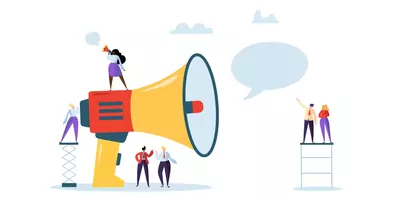
5. Increasing engagement through email marketing
Email marketing can also be part of your strategy to increase engagement on your website. The vast majority of online advertisers underestimate how strong the connection is between an email marketing campaign and website engagement rates.
For example, you created a new product page and you want to promote it. You could do this by:
Emailing your subscribers about the new product page, including a link to it and some information about the benefits of buying from that particular page.
- Send personalized content that is relevant to your audience.
- Including interactive elements (such as polls or surveys) in your emails.
- Creating engaging images and videos for your emails.
- Offering exclusive offers or discounts in exchange for feedback from your subscribers.
- Create an email marketing sequence that is relevant to your audience.
- Send emails that have a clear call-to-action and explain why the recipient should take action on it.
- Include tips, tricks or helpful advice in your emails.
- Send emails that are personalized to the recipient’s interests and needs.
- Include a sense of urgency or timeliness in your email, such as a limited-time offer.
- Send emails that are relevant to your audience’s location or demographics.
As you can see, email marketing can work wonders when it comes to increasing how engaging your website can be.
6. How can you use pop-ups and other forms of intrusive advertising to increase engagement on your website?
Pop-ups and other forms of intrusive advertising are often used to increase engagement on a website. These are usually small, fast-loading windows that appear on the user’s screen without their consent.
Pop-ups and other forms of intrusive advertising are used to get visitors to interact with your website. They are usually small, fast-loading windows that appear on the user’s screen without their consent. This way, you can collect valuable data about the person who views your content or signs up for your service. It also increases the likelihood that the person will stay longer on your website and make more purchases from you.
What is intrusive advertising?
Intrusive advertising is any type of advertisement that interferes with a user’s experience on the web. They can be annoying because they are often unsolicited, pushing, invasive, unwelcomed, irrelevant and sometimes interruptive. One type of intrusive advertising is pop-up ads that display ad banners and large, in-your-face advertisements.
5 Good intrusive advertising examples:
- Interstitials: These are Ads that cover the entire screen and must be closed before proceeding to the content.
- Autoplay video ads with sound: As it suggests, we are talking about video ads that start playing automatically without the user’s consent, often with accompanying sound.
- Pop-ups and pop-unders: These Ads can appear in a new window, on top of, or beneath the current web page. Normally banners and videos.
- “Sign Up Now!” Forms: Another common intrusive advertising tactic is the sign-up form. This can be anything from a newsletter sign-up to a free trial or contest entry. The goal is to get the user to take action, but often times these forms are placed in inconvenient places or are difficult to close.
- Pre-roll ads: These are the video ads that play before the content you wanted to watch. Many times they are unskippable which makes them very intrusive.
As you can notice, those intrusive ads can be really annoying, though you can use them to market your products, you should avoid abusing them. We better give you some intrusive advertising examples that you should NOT follow.
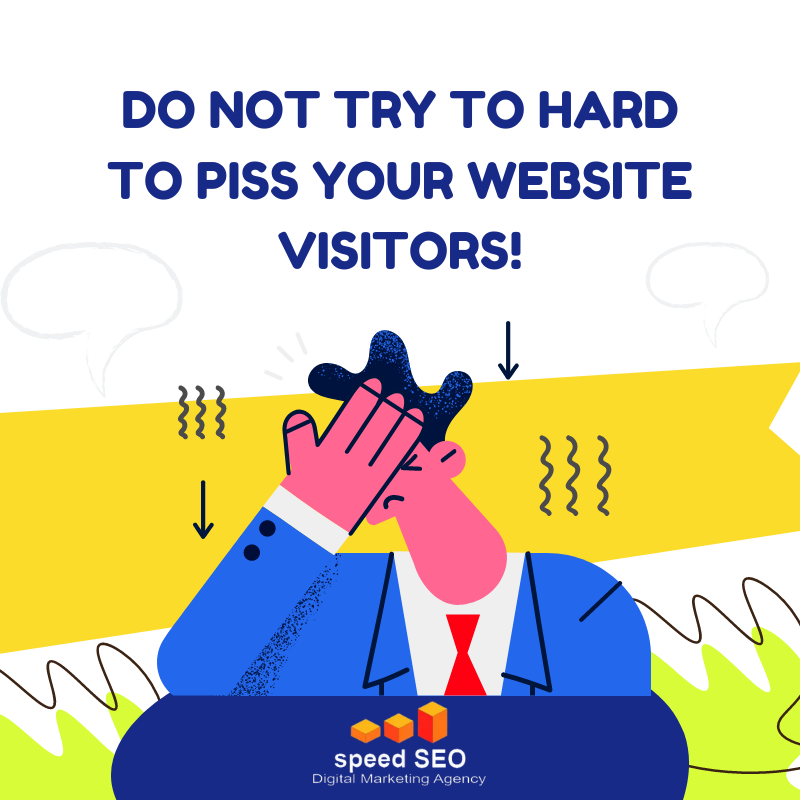
5 Bad intrusive advertising examples:
- Ad blockers: Ad blockers are software that removes ads from web pages, preventing users from seeing them. While some people find ad blockers to be a helpful tool, others see them as intrusive and disruptive.
- Timed content: Some websites have content that is only available for a limited time, after which it expires. This can be frustrating for users who want to access the content but don’t have the time to do so right away.
- Paywalls: Paywalls are a type of online subscription that allows users to access premium content on a website. While paywalls can be a great way to support website creators, they can also be seen as intrusive if they block access to important or interesting content.
- Floating ads that follow you as you scroll: These ads are designed to be difficult to ignore, but they are also very effective at driving website visitors away.
- “Download Our App!” Banners: Have you ever been browsing a website on your mobile phone and been bombarded with banners telling you to download their app? This is a common marketing strategy for companies that want to increase their app downloads, but it can be very intrusive and annoying for users.
Yes, I know what you may be thinking, “Hey, I have seen so many other types of intrusive and annoying ads”. and you are right, but it is important to know that if you feel overwhelmed by ads on pages, Google Ads or not, you can simply leave the page.♫♪ We need to make the Internet a better place, for you and for me and the entire human race ♫♪. 😋

7. How can you use calls to action to increase engagement on your website?
Yes, you can, the how, the when, and the where are all important when it comes to calls to action.
CTAs are short, simple words or phrases that users see when they’re on a website. They’re often used to get people to take action – like sign up for a mailing list, download an app, or buy a product.
CTAs can be placed anywhere on the page – near the top, bottom, left side, or right side. However, research has consistently shown that CTA placement in the hero section of a page is the most effective way to convert visitors into customers.
You want your call-to-action (CTA) buttons on the page, but you don’t want them everywhere. You’ll get the best results if you have a CTA button on each page of your website.
So, how do you know where to place the call-to-action buttons?
You want them in places where the visitors can easily see them, and where it will be easy for them to interact with them.
Keep in mind the psychology of colours when it comes to CTA. Remember the CTAs are meant to grab the attention of your visitors.
Here are some colour examples for CTAs:
- Green button – this is a common colour for CTA as it represents money and growth, natural, organic and healthy. It can also be used to represent “Go” and forward momentum.
- Red button – represents stop or danger. It is also a colour that can grab the attention of your visitors quickly as it is a strong colour.
- Blue button – this represents trust and security, which are also qualities that you want your visitors to feel when they visit your website.
- Orange button – this represents creativity, imagination and fun. It is a great colour for CTA as it will make your website visitors feel happy and excited to take action when they see the orange button.
- Yellow button – this represents happiness and sunshine, so it is a great colour to use if you want your visitors to feel happy when they take action on your website.
Engaging users means getting them to click on your CTA and convert them
There are two main types of CTA buttons: direct and indirect.
- Direct CTAs require users to enter their name and email address in order to complete the conversion process.
- Indirect CTAs don’t require any user input – instead, they rely on contextual cues (like where someone is on the site) to determine whether or not they should click on the button.
There are many different ways you can use CTA buttons to boost engagement on your website. Here are some ideas:
- Create personalized content that includes CTA buttons for readers to click on and learn more about your products/services
- Offer exclusive discounts and offers only available through clicking on CTA buttons
- Include social media sharing icons next to each CTA button to help your audience share your content on social media
- Add CTA buttons to blog posts and other articles that are relevant to your audience
- Build a conversion funnel – start with a simple CTA like “Sign Up” or “Download” and gradually add more complex options as users complete more steps in the process.
8. How can a mobile-friendly website help your website engagement?
A mobile-friendly website makes it easy for users to use your website on their phones. This means they can access the content they want without having to worry about formatting or layout issues. A mobile-friendly website also helps more people find and use your content, which increases your web traffic.

What is mobile-friendliness on websites?
Mobile-friendliness on a website refers to websites that work perfectly fine on mobile devices. This means that the site is not only user-friendly for desktop users, but also for those who access your website through smartphones and tablet computers. Mobile websites are designed to be viewed on small screens, so it is important to make sure that your website can be viewed properly on mobile devices.
In today’s society, it is important to make your website easy to navigate and user-friendly for mobile devices. Mobile friendliness means making a website responsive so that the webpage can be easily navigated with your thumb without any problems or interruptions from shutting down the device.
In today’s era of online marketing, cell phones are used by almost everyone. They are used for everything from checking email to shopping and browsing the web. For this reason, it is important that your website is mobile-friendly so that users can easily access your website on their cell phones.
It goes without saying that people are already engaging with mobile devices. And you can take advantage of this fact by making your website mobile-friendly and responsive 🙂
How can I check if my website is mobile-friendly?
I am glad you asked! Nowadays there are many tools on the Internet that allow you to check how your website adapts or responds to different screen sizes, no matter how big or small they may be. In a few words, this is called website responsiveness, or web responsive. In a few words, this is called website responsiveness or web page responsiveness.
Now, it is worth mentioning that adaptivity or responsiveness is to be measured on a per-page level, meaning that all pages on your site got to be responsive.
Now, let’s cut to the chase! here you have a list of 10 FREE to-use online tools to check if your website is mobile-friendly.
10 FREE to-use online tools to check website mobile-friendliness:
- Google Mobile-Friendly Test Tool: Is your web page mobile friendly?
- Google AMP Testing tool: Is your AMP page or web story valid?
- Google TestMySite: Improve your mobile site to boost your business.
- Google PageIsights Test Tool: Make your web pages fast on all devices
- Responsive Test Tool: Is your website/page device friendly?
- Website Planet: Responsive Checker
- Responsive Design Checker: How Responsive is your Website?
- Rank Watch: The Ultimate Mobile Responsiveness Test
- Mobi Ready: Is your site mobile ready?
- Microsft Bing: Mobile Friendliness Test Tool

9. The power of providing helpful resources for engagement rates.
This issue of “helpful resources” is why the Internet exists in the first place. Any time you create a website and decide to use it for marketing or any other reason, even if you do not want Internet traffic, you need to provide helpful resources. You need to provide resources that are helpful. Not only for yourself but also for your audience.
This way, you can get your visitors excited about your website because they can actually use the resources you provide. They are more likely to come back because they want more of what you offer.
This is how you build a community around your brand, and this is how you get people talking about your brand.
Helpful content helps your site rank higher
Providing helpful resources for engagement rates will certainly help your website or blog rank higher in search engines. Helpful resources can be provided in the form of articles, videos, and other content that users can access to learn more about your product or service or other things they’re looking for.
When users find helpful content on your website, they’re more likely to engage with your website or blog and make a purchase. This way, you can increase the number of visitors and traffic, which in turn leads to higher revenue.
The ability to learn more about your product or service is critical to SEO success. When people find helpful information on your website, they’re more likely to engage further with your website and become customers. By providing valuable and easily accessible content, you help improve results in the long run.
7 examples of helpful content on a website:
- How-to videos: Showing your audience how to do something instead of letting them figure it out. Videos work better than static images.
- ToolTip: Showing your audience a description of an item on your page that they are hovering over.
- Product comparison: Showing the differences and similarities among multiple products, including the ones of your competitors.
- Videos and images: Better if they are made with people using your product or service.
- Testimonials: Letting your customers talk about their experiences with your product or service.
- Tips and Tricks: Showing how to get the most out of a tool, product, or service.
- PopOver: Popovers can be anything informational or interactive.
When it comes to being helpful with your web content, you need to also consider people with disabilities. When doing this you will gain a few extra points with search engines. Few websites actually consider people with disabilities when creating content. But not you, you are a great business owner or marketer, and you will make it better.
But what are those features or elements that you should include?

7 Tips to make websites accessible to people with disabilities.
- Animated content: if you have a lot of text and images, it can be difficult for people with dyslexia to read them. And even if your website is responsive, this can be a problem. Therefore, you should use animated content to help people with dyslexia navigate your website.
- Text to audio: you can also add a text-to-audio feature. This way, people with visual impairment can listen to the content instead of reading it. Even if you do not have eye problems, it’s always better to listen than to read.
- High contrast: people with low vision often have trouble seeing high-contrast colours. So make sure your website has high contrast so it’s easier for people with low vision to see.
- Colour blindness: People who suffer from colour blindness can not tell the difference between certain colours. So make sure you use different fonts and font sizes to help people with colour blindness see your content.
- Text size: make sure the text size is not too small or too large. People with eye problems will have trouble seeing the content if it is too small or has trouble reading it if it is too large.
- Colour contrast: make sure your text stands out against the background so it’s easier to read. This helps everyone, not just people with vision problems.
- Formatting: make sure you use formatting to your advantage and make your website content easier for visitors to read. You can highlight important points, use bullet points, and bold the most important words in your sentences.
But that’s not all. You can also use line spacing and paragraphs to break up the text into smaller sections to make it easier to read. The most important thing is that the content of your website is easy for everyone to read.
10. Why is A/B Test Everything key to increasing your website engagement?
A/B testing is a technique that allows you to compare two versions of a webpage or ad and see which one performs better. This information can help you make decisions about what content to keep on your website, which ads to run, and how to improve user experience.
The goal of A/B testing is to increase website engagement by comparing two versions of a page or ad and seeing which one performs better. This information can help you make decisions about what content to keep on your site, which ads to run, and how to improve the user experience.
A/B testing is important because it allows you to experiment with different combinations of elements (texts, images, colours) in order to find the combination that converts best. By doing this regularly, you can optimize your site for increased engagement and conversion rates.
There are many tools available that allow you not only to execute A/B tests but also to analyze the results quickly so that you can take action based on feedback.
5 Best FREE tools for A/B Testing
- VWO: Split testing tool
- Google Optimize: Split Testing Tool by Google
- Nelio: A/B Test Everything
- Vanity: Easy A/B Testing
- A/B testing using HotJar: Heatmaps
Do you only need A/B Testing only to increase your website engagement?
No, you need to A/B Test everything related to your online marketing efforts. The better information you receive about what is working and what is not, the better decisions you will make.
Did you know that hundreds of businesses spent tons of money on marketing and advertising, but they didn’t even bother to test which advertisement was more effective?
Well, you don’t want to make the same mistake. It is important that you A/B Test your online marketing efforts.
10 Tips you can implement to increase your website engagement using A/B testing:
- Use different CTA colours: When you want to increase your conversion rates, it is important that you use different colours for your CTA buttons.
- Use a countdown timer: If you want people to take action, giving them a deadline might be the thing that will encourage them to do it.
- Use a variety of headings: Headings are the first thing your visitors see on your website. Therefore, use a variety of headings and test which one works better.
- Use a variety of images: Images can also affect the conversion rate. Therefore, a test of which images work better.
- Test a landing page with and without video: It’s important to test a page with a video and one without so you can see which page works better.
- Test a page with and without an image: Also test a page with and one without images to see which page works better.
- Test a page with different colours: Colours can also have an impact on conversion rates. So test different colours and see which performs better.
- Long or short form: The answer may surprise you. Let your audience show you which page performs better.
- Test an old landing page with a new one: also test an old landing page with a new one to see which one performs better.
- Test a page with a sign-up form in the header: Sometimes forms work wonders when you place them in the header, but sometimes they do not.

What are website engagement metrics?
Engagement metrics are statistics that measure the level of interaction or engagement a user has with your content or website. They can include things like:
- Pageviews
- Time on site
- Unique visitors
- Returning visitors
- Abandonment rate
These stats help businesses understand how well their content is performing and which parts of their website are attracting users the most. By understanding these numbers, businesses can make adjustments to their strategy accordingly.
Where can I see website engagement metrics?
If you are looking to see the engagement metrics of your website, then Google Analytics is a great place to start. Just create a custom report and filter out all the traffic that comes from social media.
What’s a Good Engagement Rate in Google Analytics 4?
A high interaction rate is a good sign that your content is resonating with readers and encouraging them to read on. The number of people interacting with your content can be measured in a number of ways.
One way to measure engagement is to look at the percentage of unique visitors who have interacted with your content. This metric can be found on the home page of GA4 > on the third tab to the right on the > Average Engagement Time tab.
This metric is a good indicator of how useful your content is to readers. The metric should ideally be above 3 minutes, the higher the better.
Average Engagement Time also tells you what type of content resonates with your audience and encourages them to engage with your content.
Engagement is calculated based on the number of unique visitors who interacted with a piece of content, divided by the total number of unique visitors, and then multiplied by 100%.
4 Common mistakes that can lead to low engagement on websites?

Common mistakes that can lead to low engagement on websites include not creating engaging content, not people-first content, a website taking too long to be interactive, and not targeting the right audience.
- Many businesses make the mistake of not creating engaging content. Engaging content is content that is interesting to users and draws them in.
- People-first content is content that focuses on the users and their needs, not the company.
- A website that takes too long to be interactive is frustrating users and can lead to them leaving the site.
- Finally, businesses should target the right audience when designing their website. If a business is marketing to the wrong audience, they are wasting its time and money.
Avoiding engagement pitfalls
Pitfalls are mistakes companies make when trying to connect with their audience. These include using social media incorrectly, sending the wrong type of email, or creating ineffective content.
Companies often make mistakes when they don’t use social media or email properly. For example, they send too many promotional emails instead of connecting with their followers on Twitter and Facebook. Or they create ineffective content that doesn’t engage readers enough to get them to take action.
If email marketing isn’t used properly, it can also lead to engagement problems in other ways. For example, companies might publish irrelevant information or pitch products without first properly portraying their brand values. This could alienate customers and damage their relationship with them over time.
By understanding how engagement works and how to avoid common pitfalls, you as a business owner stand a better chance of reaching your audience and converting them into customers.
How can you increase engagement with a specific audience?
The goal is to engage your audience so they take action based on what you’ve shared—whether that’s liking or sharing your posts on social media platforms or clicking through an ad campaign aimed at them specifically.
But, in order to engage your targeted audience, you need to understand what they want, what are the problems they want to solve, and how you can help.
Once you know what they need you can start focusing on providing that type of content to them. But is it there a place where you can actually see what a specific audience is looking for?
Yes, there is a place called, the internet! 😋
No worries, I will point you to the right places where you can find these answers.
5 websites to find out what a specific audience is looking for:
Increasing website engagement in a nutshell
⚡ Provide valuable content to keep visitors coming back!
Keeping your website’s visitors engaged is essential for creating a successful online presence. Content should be focused on providing value, and should be updated regularly to provide new information or insights. By keeping your website visitor engagement a top priority, you can help them stick around longer and explore the site further.
If you want to improve website engagement for your business, these tips will get you started.
Key Points:
- Engaging content is one of the most important ways to increase website engagement.
- Effective user interfaces are another way to increase engagement on your website.
- Targeting the right audience can also help you increase engagement on your website.

